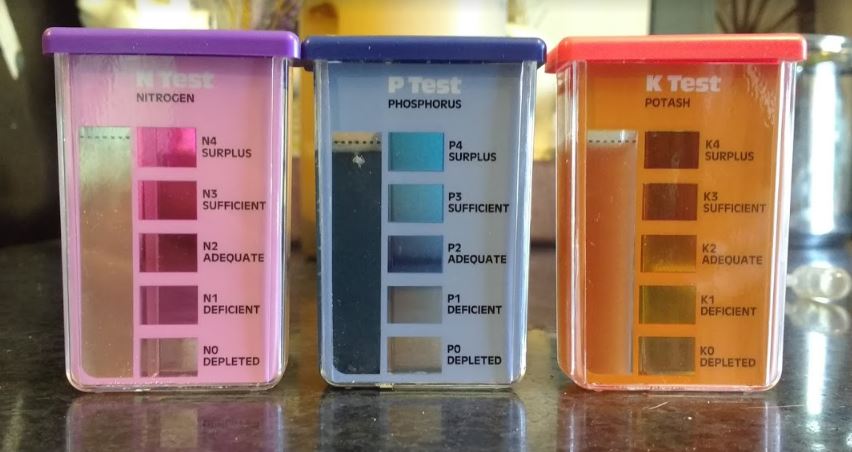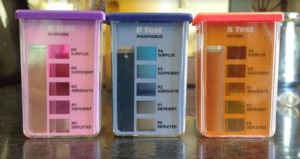Welcome to Post No. 5 in the “Organic Growers’ Tool Kit” blog series!
In case you missed the previous posts in this series, here is the link:
Read More: The Organic Growers’ Tool Kit Series
In this article, we’re going to take a look at the role of nitrogen, phosphorous, and potassium (N-P-K) in plant development—and the special challenges organic gardeners face when managing the “Big 3.”
Also, keep in mind that even though N-P-K are the nutrients your plants need the most of, there are at least 14 other micronutrients that are essential to plant health. We won’t have time to cover those nutrients in this article, but we’ll get into them in future posts.
Why Does N-P-K Matter?
I am going to seriously overgeneralize the roles of N-P-K in plant growth because otherwise it’d take us hours to get through this information! I am also going to take N-P-K out of order for a minute so I can draw some parallels between plants and humans to help explain these nutrients related to plant health.
My hope is that this shorthand explanation will be a helpful starting point for your studies.
Nitrogen (N) = Protein for Plants
Generally, nitrogen is protein for plants. It’s the basic building block that allows plants to create chlorophyll and turn sunlight and nutrients into plant matter. In the same way that humans require protein for muscle production, plants require nitrogen for leaf production and growth.
The amount of nitrogen needed varies greatly among different plants. For example, plants that are all about leaf production—such as grass, lettuce, and cabbage—tend to need higher levels of nitrogen than plants focused on roots, such as beets, carrots, and turnips.
Now, it would be so great if we could just load our soil with nitrogen and let each plant takes what it needs. Unfortunately, it just doesn’t work that way.
Too much nitrogen for the plants you are growing can result in stunted root growth and excessive leaf production rather than fruit production. It can also damage plants. Legumes, such as peas or beans, make their own nitrogen. So for them, lots of nitrogen in the soil can even cause death by overdosing.
For best production, you need to give plants the nitrogen they need, but not more. This is why monitoring and adjusting nitrogen levels in your soil can really help maximize your food production without doing harm in the process.
Potassium (K) = Fat for Plants
Potassium is like fat for plants. Similar to the role that fat plays in human reproduction, if plants don’t have sufficient potassium, they can’t reproduce. Much of what we humans like to eat from plants are the reproductive parts—as in the fruit.
Tomatoes, for example, produce fruit that contains seeds as its primary means for producing new tomato plants in the future. A tomato plant in potassium-depleted soil is going to make a lot less fruit than it would in soil with sufficient potassium.
Again, as with nitrogen management, too much potassium can also cause problems. Similar to the way that the wrong pH can make it impossible for a plant to take up necessary nutrients, too much potassium can cause plants to stop taking up nitrogen, calcium, and magnesium, which are all critical for plant health and production.
Phosphorous (P) = Immune System Support for Plants
Since nitrogen is protein and potassium is fat for plants, I’ll bet you were expecting me to say that phosphorous is like carbohydrates for plants. Actually, the cool thing about plants is that when they have sufficient nitrogen and phosphorous, they make their own carbohydrates, or sugars, through photosynthesis.
So, plants don’t need you to give them carbohydrates. What they do need, though, is an appropriate dose of phosphorous to give them general health support so they can continue to photosynthesize sugar proteins even when environmental and soil conditions aren’t perfect.
Phosphorous, in the right amounts, helps make plants radiantly healthy and productive. In the wrong amounts, it makes plants the equivalent of a human with perpetual health conditions—as in, miserable; symptomatic (sick, diseased, etc.); and not usually very productive.
The Complex Matrix of N-P-K, Organic Matter, and Soil-Texture Type
Now that you have the gist of what these macronutrients mean for your plants, I have to tell you the bad news about N-P-K and organic growing:
It is much harder to manage N-P-K when you are in the process of building soil.
Here’s why.
N-P-K and Organic Matter
In the first article of our Organic Growers’ Tool Kit series, I explained how soil inhabitants use organic matter to cycle nutrients. Literally, dead stuff becomes food. Food becomes poop. Poop becomes nutrients. Nutrients become living stuff. Living stuff becomes dead stuff. And then we start all over again.
As an organic grower, you’ll be adding lots of organic matter to your garden. Some of it will be fresh, like mulch or cover crops. Some will be aged, like compost. Some will be naturally occurring, like dead insects or birds droppings.
The more organic life you have in your soil, the more stuff will be in a state of transformation all the time. This is a really good thing. It means your soil food web is thriving.
However, since this is a new soil city, not all parts are fully functional yet.
Depending on which soil pioneers show up first, and how quickly other stuff moves in, your N-P-K production levels will be pretty erratic at the outset of soil-building.
In other words, N-P-K and other nutrients will become available on nature’s schedule, not on your planting schedule.
Depending on the state of your soil when you start gardening, the same application of organic matter one year could have a completely different result the next. Also, the content of your organic matter sources probably vary, too, making outcomes even more unpredictable.
N-P-K and Soil Texture Type
Your soil-texture type also plays a role in how available nutrients are in your soil. In clay soil, because clay particles naturally bind with certain minerals, clay can actually bind up nutrients pretty easily if you add too much at once.
In sandy soils, heavy rains or overwatering can wreak havoc on your nutrient content. Many of the nutrients in organic matter are water soluble and can leach out before your plants need them, which makes managing N-P-K tricky.
Silty soils hold nutrients well. But they also hold water well. This can impact a plant’s ability to uptake nutrients. In water-logged soils, nutrients may be diluted. So, when plants drink them in, they may get fewer nutrients from the same soil during wet times than they would during drier times.
All this means that when you are growing organically by continuously improving the state of your soil, standard recommendations for fertilizer will not be appropriate for your garden.
So what’s an organic gardener to do?
For more information on using fertilizer like a short-term multivitamin to help your garden grow now—while you are in the process of building good organic soil by applying organic matter on a regular basis—check out our article on “Organic Nitrogen Fertilizer: 6 Secrets to Soil Health.”
Read the Other Articles in the Organic Growers’ Tool Kit Series Here
What Do You Think?
What are your strategies for managing nitrogen, phosphorous, and potassium while you’re also building up your soil with organic matter? Let us know in the comments!

Tasha Greer is a regular contributor to The Grow Network and has cowritten several e-books with Marjory Wildcraft. The author of “Grow Your Own Spices” (December 2020), she also blogs for MorningChores.com and Mother Earth News. For more tips on homesteading and herb and spice gardening, follow Tasha at Simplestead.com.










COMMENTS(6)
Ah. I see. So I’ll have some trouble keeping things balanced since I’m trying to transform clay into good soil. Makes sense.
Hey Scott – Soil can be a bit tricky to figure out at first. But, if you keep trying, and use stuff like soil tests and plant observation to identify deficiencies before they become problems, then hopefully you can prevent the challenges a lot of gardeners run into when building soil. With your plant observation skills at wild foraging and knowing the medicinal benefits of plants, I bet you can also translate that into good soil management practices too. Good luck!
For my banana trees, pretty much what I throw at them doesn’t seem to harm them. For the big guys, I use a cylindrical wire mesh exposed compost heap. Anything organic gets dumped inside and I just neglect it. The soil critters must have been hard at work because the level keeps dropping and I just replenish it whenever. I let the surrounding plants send out roots in that direction if they are interested and take whatever they want. For the same reason, I have scattered pots of eggshells and seashells and I pour pee into them. I don’t yet have any no-till raised bed garden where I can harvest enough vegetables daily. I am just conducting many and various experiments from Hugelkultur to woodchip beds and JADAM concoctions until I hit the groove. Right now I think my soil is overnourished since I have been dumping bags of cut grass all over. I am experimenting with potted vegetables and have to resort to washing soil to get rid of silt so that it can drain well. Multiple concurrent experiments and multiple failures. One day ……
Hey Edward,
Sounds like you are trying a lot of good ways to improve your soil fertility.
I do a lot of composting in trenches around my fruit trees which is similar to what you do with your wire mesh towers for your bananas. (We have too many critters to leave out compost out above ground.) It works well for everything that can tolerate a pH above 5.5, but not so great for blueberries. They prefer pine needles and oak leaves to keep the soil acidic.
I love hugelkulturs too. We had a few areas that were so degraded, that was the only way we could get things to grow. I planted rhubarb on one of the piles and those plants starts producing about 2 months before my in-ground rhubarb. There are definitely thermal benefits for hugels.
Grass clippings are a great source of nitrogen. We usually just chop and drop and leave in place, so I’ve never had nitrogen overload from them. But I can see where large amounts might be too much for some plants. I bet corn would love to grow in all those decomposed grass clippings though.
Have you tried mounded beds for your silt problem? By exposing the sides of your beds to air, they dry faster, also the water settles lower, below the root zone, so plants don’t drown. We had some silt issues in our bottomlands and that worked well for us.
Experimentation and observation are some of the best tools to use to really start to understand soil and figure out what works for your conditions! It sounds like you are on the right track to building soil fertility, solving problems, and using natural resources that others treat as waste (e.g. urine).
Keep us posted on your adventures in soil building!
Tasha
This is why crop rotation and cover crops (especially nitrogen fixing cover crops) are so very important. Certain plants add to the soil, some are heavy on extracting certain elements. Crop rotation balances this and cover crops add nutrients as well as donate roots and organic matter that benefit soil. Just remember that fresh organic matter (especially wood chips) is a nitrogen magnet as it needs nitrogen in order to break down(it locks up that nitrogen and will not release it until it has composted). So it’s best to compost organic matter along with high nitrogen material like chicken compost and soiled livestock bedding as it speeds up composting and once matured, that compost will contain all the bioavailable nitrogen (and almost everything else) your plants could want. It’s also a good idea to do soil testing often (while you are learning) and then at least once a year after you have it dialed in. Soil testing is the only way to figure out what your local soil might be missing or identify any problems that may need to be fixed/balanced. What your soil needs mainly depends on what you use it for/grow in it and that puzzle is indigenous to you. Soil ph is also critical because plants can’t take in the nutrients they need if the ph is off, even if the nutrients are there and different plants may like/require a different ph. It’s complicated, but not too difficult for anyone with a logical mind to figure out. However farming/gardening is not for everyone. Some folks just can’t seem to figure it out.
Hey cre8tiv369,
It sounds like we have similar philosophies on soil care. I am kind of a crop rotation/experimentation junkie. I am constantly perfecting my rotations and testing my soil to see how they do. I rotate not only my crops and cover crops, but also the various forms of compost we make on our homestead.
That’s a good point about woodchips. I have never had a problem using them on top of my garden beds or around my perennial plants. But, one time I rearranged part of my garden, and dug new paths (I use mounded beds). When I put the soil from the paths on top of some not entirely decomposed wood chips from the year before, I created pockets of nitrogen deficiency. It took about 3 months for the soil life to finish the decomposition on the wood chips and release the nitrogen. So, now I know never to mix partially decomposed wood chips into soil, it must stay on top!
I love working with soil, but it certainly took me a while to get a feel for it. I think a lot of people try to use formulas such as just adding 3-4 inches of compost every year, but that won’t always work. Soil tests and an ability to “read” soil by paying attention to the health of your plants can really help!
Thanks for sharing your great advice and experience.
Tasha